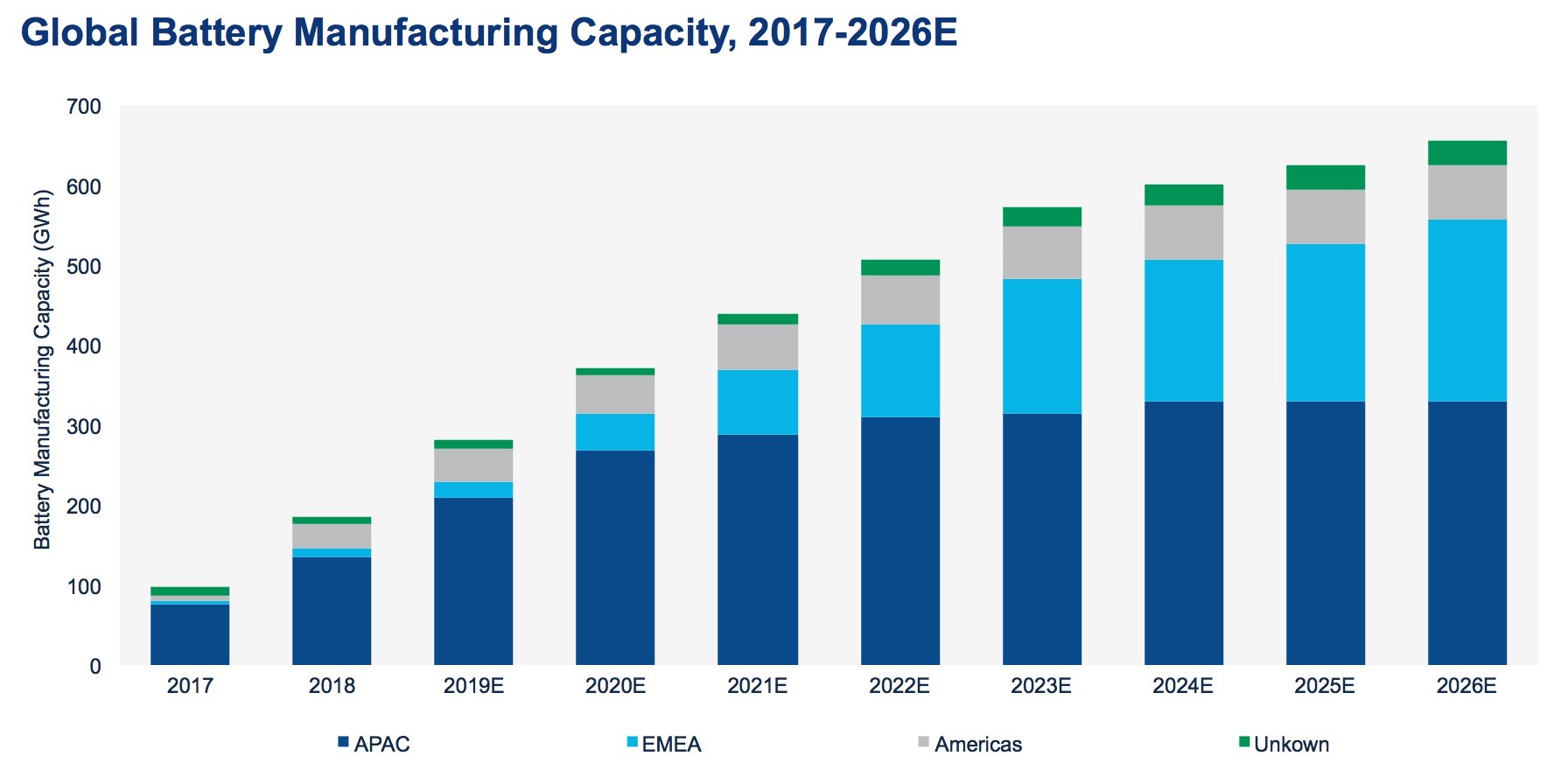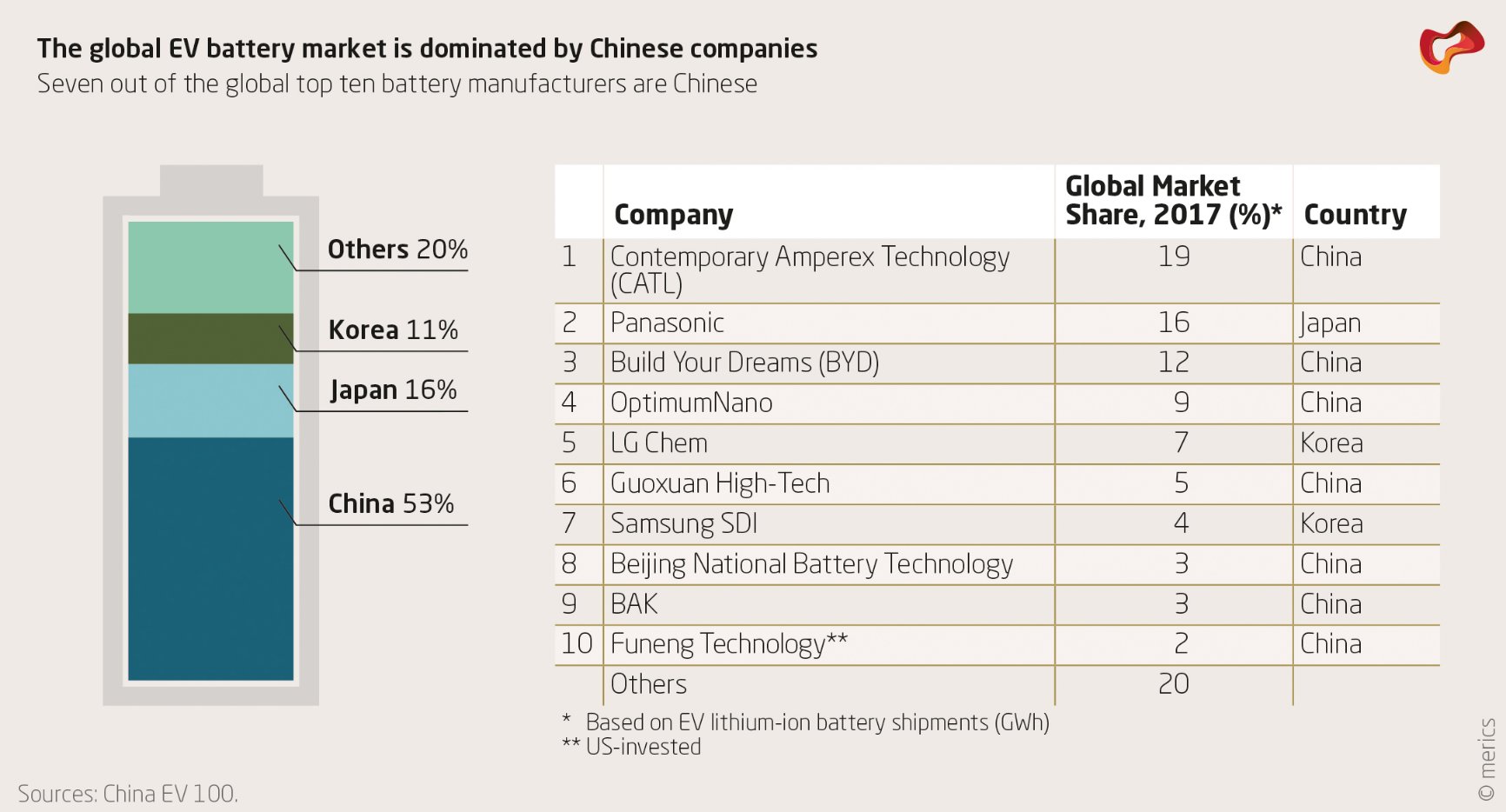China is a world-dominating manufacturer. For years, the country has excelled at building everything from key chains to mobile phones to solar panels.
Now, China is eyeing taking over the market for making batteries.
“Not only has the country seen a slew of investments in battery facilities, but over the past couple of years several Chinese battery vendors have begun emerging into battery giants, joining the likes of Tier I South Korean and Japanese vendors,” said Mitalee Gupta, energy storage analyst at Wood Mackenzie Power & Renewables.
China currently owns a majority of global lithium-ion battery production, with more than 60 percent of global manufacturing capacity today, according to Wood Mackenzie.
The key driver of China’s battery manufacturing ramp-up has been the generous subsidies offered by the Chinese government solely to domestic vendors. “This has enabled China to keep ownership and control of the battery industry, and the use of licensing procedures in the country has held off foreign battery vendors from taking over,” said Gupta.
But while China’s domestic battery industry is already booming, it’s really only just getting started. According to Woodmac, planned battery manufacturing capacity expansion in China — for all battery applications and chemistry types — is expected to grow by more than 2.5 times by 2026.
Battery manufacturing in Europe is also projected to accelerate in the coming years, but won’t reach Asia's level. By 2026, the Europe, Middle East and Africa (EMEA) region will account for almost 228 gigawatt-hours of lithium-ion cell manufacturing capacity per year, compared to the Asia-Pacific region at nearly 345 gigawatt-hours of cell manufacturing capacity per year.

Source: Wood Mackenzie
This increase is driven in large part by expected growth in the global electric vehicle market. According to Bloomberg New Energy Finance, annual demand for lithium-ion batteries from new EV sales could reach nearly 1,400 gigawatt-hours by 2030. Chinese manufacturers have their sights set on supplying the lion's share of that market need.
China’s leading EV battery producers, BYD Co. and Contemporary Amperex Technology Co. (CATL), already have plans to exponentially increase their battery production capacity over the next two years. With new gigafactories in the works, BYD and CATL are poised to surpass production levels at Tesla/Panasonic. And as product quality improves, these and other Chinese firms stand to become leading EV battery suppliers worldwide, not just domestically.
In the fifth and final installment of this GTM Squared series on China’s rapidly growing EV market, we look at the country’s giant EV battery manufacturing sector, the foundation of China’s growing command of the EV market overall.
Click here to read Part 1, Part 2, Part 3 and Part 4 in this series, which cover Chinese EV sales, charging infrastructure, domestic industry policy drivers and leading EV companies.
China's market leaders: BYD and CATL
China has built up an arsenal of battery manufacturers. According to Shenzhen Gaogong Industry Research, there were 90 EV battery manufacturers operating in China in 2018, thanks to more than $10 billion in government subsidies poured into the sector since roughly 2012.
EV batteries have been a central focus for China, because they can account for around 50 percent of a car’s total production cost, according to a report by the Columbia University Center for Global Energy Policy, Electric Vehicle Charging in China and the United States. “China has spared no effort to foster this industry across the entire supply chain, including raw materials, components, battery design, manufacturing, and recycling,” the report states.
The government has also made life harder for foreign battery producers. Starting in 2015, China’s Ministry of Industry and Information Technology began issuing a “white list” of batteries approved for use in EVs that would be eligible to receive subsidies. Batteries from LG Chem and Samsung SDI didn’t make the list initially, even though the South Korean companies operate factories in China, but they were later accepted.
Today, BYD and CATL top the list of Chinese EV battery manufacturers to watch.
BYD, China’s first major entrant into the field, is currently building what could soon become the largest vehicle-battery factory in the world. The plant, located in Qinghai province, will have an annual capacity of 24 gigawatt-hours once it’s fully up and running later this year. That’s enough to outfit 1.2 million BYD Tang electric cars, according to the manufacturer, which is backed by Warren Buffett.
BYD invested 10 billion yuan ($1.5 billion) in the factory, which will be the size of roughly 140 soccer fields and equipped with around 100 robots to handle building and logistics. The company chose to build in Qinghai because it’s home to 83 percent of China’s lithium.
Once complete, the new 24 gigawatt-hour plant will boost BYD’s total capacity to 60 gigawatt-hours of battery capacity by 2020.
Tesla is giving BYD a run for its money in the competition for “largest EV battery factory in the world,” however. Tesla’s Nevada gigafactory currently has around 23 gigawatt-hours of battery output per year, but plans to reach 35 gigawatt-hours eventually.
Tesla is also looking to expand battery production in China, to go along with its new Shanghai EV plant. Rather than work with Japan's Panasonic, Tesla’s existing battery partner, the company is rumored to be exploring a deal with China’s own CATL.
CATL currently leads the globe in EV battery production. Not only that, but like BYD and Tesla, it’s also trying to build one of the single largest EV battery factories on Earth.

Source: Mercator Institute for China Studies
CATL’s 24 gigawatt-hour factory in its headquarter city Ningde is scheduled for completion around 2020, shortly after BYD finishes its facility. Once CATL’s new plant comes online, the company’s total production capacity will jump to 88 gigawatt-hours per year.
That means by next year both of China’s leading EV battery manufacturers could be well ahead of Tesla/Panasonic in overall production, even if the Nevada gigafactory reaches its full potential.
What’s more, CATL is already making plans to boost production further. And this time, it’s looking abroad.
Last year, CATL announced it will invest 240 million euros ($280 million) to build its first battery cell factory in Europe, which will supply lithium-ion batteries to BMW. The plant in Erfurt, Germany is slated to produce roughly 14 gigawatt-hours of supply by 2022, but could ultimately make much more.
CATL is now looking to expanding the German plant to 100 gigwatt-hours, as the company seeks to serve automakers all across the European continent.
“We want to supply all the OEMs (manufacturers) in Europe,” CATL Chairman Robin Zeng said in an interview with Reuters.
Beating the competition in a crowded field
BYD and CATL stand out, but there are dozens of other Chinese EV battery manufactures looking to capture a share of the market.
Tianjin Lishen is another large Chinese battery manufacturer, which reportedly tried to ink a battery production deal with Tesla. Beijing National Battery Technology is another leading company with a major factory under construction. Then there are smaller payers like EVE Energy, which is partnering with Israeli startup StoreDot to produce fast-charging batteries in China.
Similar to China’s automobile market, not all companies are expected to survive in the years to come, particularly as the country shifts away from a primarily state-sponsored industry to a more competitive one. China’s OptimumNano Energy suspended production for six months last year, as subsidy-reliant customers dropped their EV orders.
The Chinese government is not only cutting subsidies for vehicles, but it is also reducing support for battery plants. That could put a dent in China’s growth trajectory, especially since BYD and CATL also appear to be feeling the pinch.
Of the 90 EV battery manufacturers in China in 2018, "Only about 20 will survive eventually," Tang Jin, chief researcher at Mizuho Bank's international business relations department, told the Nikkei Asian Review.
Cementing supremacy
Wood Mackenzie’s Gupta doesn’t see the subsidy changes in such stark terms.
“I think we might see a temporary slowdown, but overall we'll still continue to see growth in battery manufacturing because the industry in China did start with government subsidies, but vendors are now not only supplying to the domestic market, they’re also selling in foreign markets,” she said.
“Several vendors have also developed partnerships with automotive vendors to supply EV batteries,” she added.
Furthermore, some recent policy changes stand to make Chinese battery manufacturers more competitive. According to Gupta, most of the innovation in Chinese EV batteries is driven by changes in the country’s new energy vehicle mandate, which rewards longer-range vehicles and is pushing manufacturers to improve battery density.
Chinese companies are responding by not only improving the quality of their existing lithium-ion batteries, but also by shifting toward batteries composed mainly of nickel manganese and cobalt, which offer higher energy density.
Due in large part to the Chinese government’s strategic focus on EVs, domestic battery-makers are poised to “cement their supremacy,” according to the Mercator Institute for China Studies (MERICS), a leading European provider of policy-oriented research on China.
“The case of China’s battery industry shows how government supported demand for EVs and protectionist policies led to a thriving domestic market that has produced national, and increasingly global champions,” according to MERICS. “It serves as a model case of China’s state-led approach to emerging industries that puts free market economies to the test.”
The CSIS report echoed this point.
“Even though China does not have the world’s most innovative battery makers, their technology is not far behind the world’s leaders, they have developed the entire supply chain, and they are aggressively scaling up their production capacity,” it states.
“The result of these efforts is that the cost of batteries, and with them full cars, is falling, while driving range and other signs of quality are rising.”